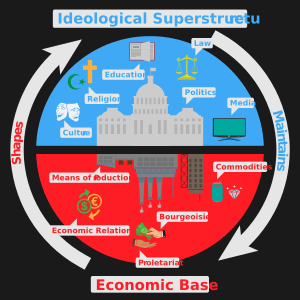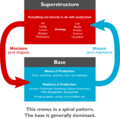Base and superstructure facts for kids
In Marxism, a way of understanding society, people talk about two main parts: the base and the superstructure. Think of society like a building. The base is the foundation, and the superstructure is everything built on top of it. These two parts are connected and influence each other.
Contents
Base and superstructure
The Base
The base is all about the economy. It includes everything needed to produce things, like land, factories, tools, and raw materials. These are called the means of production.
The base also includes the relations of production. This means how people organize themselves to work and produce. For example, it's about who owns the factories and who works in them. It's about the different social classes, like employers and employees.
The Superstructure
The superstructure is made up of all the non-economic parts of society. These are the ideas, rules, and beliefs that shape how people live and think.
Examples of the superstructure include:
- Government and laws
- Education (schools)
- Religion
- Culture (like art, music, and traditions)
- Family structures
The superstructure often shows the interests of the most powerful group in society.
How They Work Together
The base, or the economy, largely shapes the superstructure. For instance, the way a society produces goods affects its laws, schools, and even its art.
In turn, the superstructure helps to keep the base working the way it does. It supports and defends the economic system. For example, in a capitalist society, schools might teach students skills needed for jobs. They might also teach ideas that make capitalism seem fair and good.
Both the base and the superstructure need each other to function. They also change and develop over time as society evolves.
Images for kids
See also
 In Spanish: Infraestructura y superestructura para niños
In Spanish: Infraestructura y superestructura para niños



